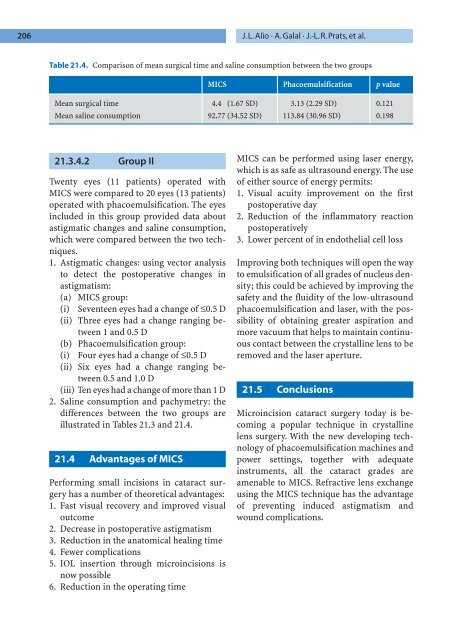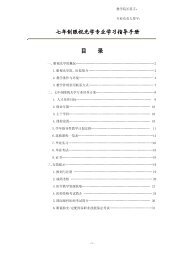Refractive Lens Surgery
Refractive Lens Surgery
Refractive Lens Surgery
You also want an ePaper? Increase the reach of your titles
YUMPU automatically turns print PDFs into web optimized ePapers that Google loves.
206 J.L. Alio · A. Galal · J.-L.R. Prats, et al.<br />
Table 21.4. Comparison of mean surgical time and saline consumption between the two groups<br />
21.3.4.2 Group II<br />
Twenty eyes (11 patients) operated with<br />
MICS were compared to 20 eyes (13 patients)<br />
operated with phacoemulsification. The eyes<br />
included in this group provided data about<br />
astigmatic changes and saline consumption,<br />
which were compared between the two techniques.<br />
1. Astigmatic changes: using vector analysis<br />
to detect the postoperative changes in<br />
astigmatism:<br />
(a) MICS group:<br />
(i) Seventeen eyes had a change of ≤0.5 D<br />
(ii) Three eyes had a change ranging between<br />
1 and 0.5 D<br />
(b) Phacoemulsification group:<br />
(i) Four eyes had a change of ≤0.5 D<br />
(ii) Six eyes had a change ranging between<br />
0.5 and 1.0 D<br />
(iii) Ten eyes had a change of more than 1 D<br />
2. Saline consumption and pachymetry: the<br />
differences between the two groups are<br />
illustrated in Tables 21.3 and 21.4.<br />
21.4 Advantages of MICS<br />
Performing small incisions in cataract surgery<br />
has a number of theoretical advantages:<br />
1. Fast visual recovery and improved visual<br />
outcome<br />
2. Decrease in postoperative astigmatism<br />
3. Reduction in the anatomical healing time<br />
4. Fewer complications<br />
5. IOL insertion through microincisions is<br />
now possible<br />
6. Reduction in the operating time<br />
MICS Phacoemulsification p value<br />
Mean surgical time 4.4 (1.67 SD) 3.13 (2.29 SD) 0.121<br />
Mean saline consumption 92.77 (34.52 SD) 113.84 (30.96 SD) 0.198<br />
MICS can be performed using laser energy,<br />
which is as safe as ultrasound energy. The use<br />
of either source of energy permits:<br />
1. Visual acuity improvement on the first<br />
postoperative day<br />
2. Reduction of the inflammatory reaction<br />
postoperatively<br />
3. Lower percent of in endothelial cell loss<br />
Improving both techniques will open the way<br />
to emulsification of all grades of nucleus density;<br />
this could be achieved by improving the<br />
safety and the fluidity of the low-ultrasound<br />
phacoemulsification and laser, with the possibility<br />
of obtaining greater aspiration and<br />
more vacuum that helps to maintain continuous<br />
contact between the crystalline lens to be<br />
removed and the laser aperture.<br />
21.5 Conclusions<br />
Microincision cataract surgery today is becoming<br />
a popular technique in crystalline<br />
lens surgery. With the new developing technology<br />
of phacoemulsification machines and<br />
power settings, together with adequate<br />
instruments, all the cataract grades are<br />
amenable to MICS. <strong>Refractive</strong> lens exchange<br />
using the MICS technique has the advantage<br />
of preventing induced astigmatism and<br />
wound complications.



